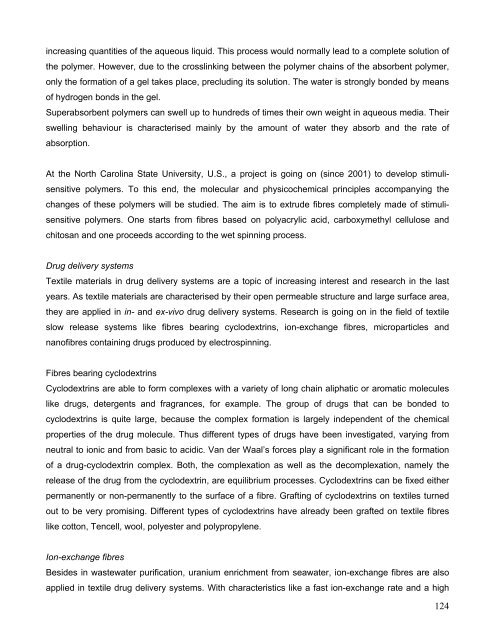Clevertex - Grado Zero Espace Srl
Clevertex - Grado Zero Espace Srl
Clevertex - Grado Zero Espace Srl
You also want an ePaper? Increase the reach of your titles
YUMPU automatically turns print PDFs into web optimized ePapers that Google loves.
increasing quantities of the aqueous liquid. This process would normally lead to a complete solution of<br />
the polymer. However, due to the crosslinking between the polymer chains of the absorbent polymer,<br />
only the formation of a gel takes place, precluding its solution. The water is strongly bonded by means<br />
of hydrogen bonds in the gel.<br />
Superabsorbent polymers can swell up to hundreds of times their own weight in aqueous media. Their<br />
swelling behaviour is characterised mainly by the amount of water they absorb and the rate of<br />
absorption.<br />
At the North Carolina State University, U.S., a project is going on (since 2001) to develop stimulisensitive<br />
polymers. To this end, the molecular and physicochemical principles accompanying the<br />
changes of these polymers will be studied. The aim is to extrude fibres completely made of stimulisensitive<br />
polymers. One starts from fibres based on polyacrylic acid, carboxymethyl cellulose and<br />
chitosan and one proceeds according to the wet spinning process.<br />
Drug delivery systems<br />
Textile materials in drug delivery systems are a topic of increasing interest and research in the last<br />
years. As textile materials are characterised by their open permeable structure and large surface area,<br />
they are applied in in- and ex-vivo drug delivery systems. Research is going on in the field of textile<br />
slow release systems like fibres bearing cyclodextrins, ion-exchange fibres, microparticles and<br />
nanofibres containing drugs produced by electrospinning.<br />
Fibres bearing cyclodextrins<br />
Cyclodextrins are able to form complexes with a variety of long chain aliphatic or aromatic molecules<br />
like drugs, detergents and fragrances, for example. The group of drugs that can be bonded to<br />
cyclodextrins is quite large, because the complex formation is largely independent of the chemical<br />
properties of the drug molecule. Thus different types of drugs have been investigated, varying from<br />
neutral to ionic and from basic to acidic. Van der Waal’s forces play a significant role in the formation<br />
of a drug-cyclodextrin complex. Both, the complexation as well as the decomplexation, namely the<br />
release of the drug from the cyclodextrin, are equilibrium processes. Cyclodextrins can be fixed either<br />
permanently or non-permanently to the surface of a fibre. Grafting of cyclodextrins on textiles turned<br />
out to be very promising. Different types of cyclodextrins have already been grafted on textile fibres<br />
like cotton, Tencell, wool, polyester and polypropylene.<br />
Ion-exchange fibres<br />
Besides in wastewater purification, uranium enrichment from seawater, ion-exchange fibres are also<br />
applied in textile drug delivery systems. With characteristics like a fast ion-exchange rate and a high<br />
124

















